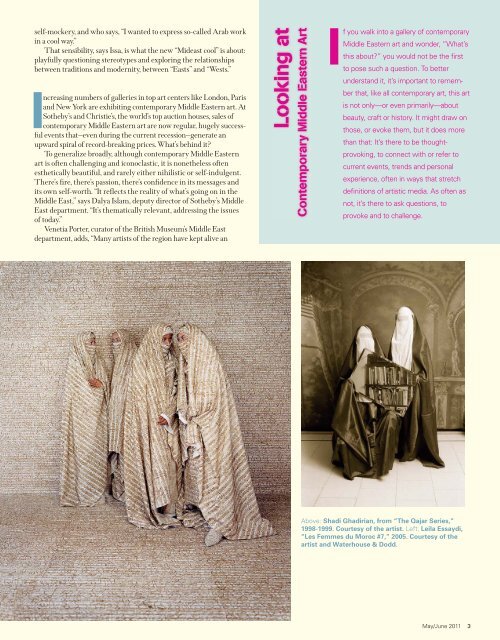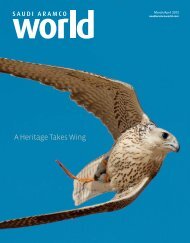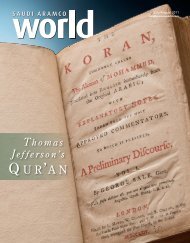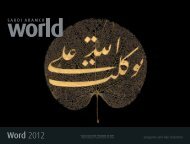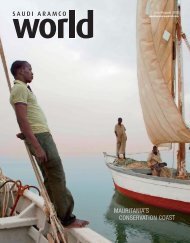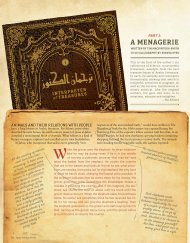MIDEAST - Saudi Aramco World
MIDEAST - Saudi Aramco World
MIDEAST - Saudi Aramco World
Create successful ePaper yourself
Turn your PDF publications into a flip-book with our unique Google optimized e-Paper software.
self-mockery, and who says, “I wanted to express so-called Arab work<br />
in a cool way.”<br />
That sensibility, says Issa, is what the new “Mideast cool” is about:<br />
playfully questioning stereotypes and exploring the relationships<br />
between traditions and modernity, between “Easts” and “Wests.”<br />
Increasing numbers of galleries in top art centers like London, Paris<br />
and New York are exhibiting contemporary Middle Eastern art. At<br />
Sotheby’s and Christie’s, the world’s top auction houses, sales of<br />
contemporary Middle Eastern art are now regular, hugely successful<br />
events that—even during the current recession—generate an<br />
upward spiral of record-breaking prices. What’s behind it?<br />
To generalize broadly, although contemporary Middle Eastern<br />
art is often challenging and iconoclastic, it is nonetheless often<br />
esthetically beautiful, and rarely either nihilistic or self-indulgent.<br />
There’s fire, there’s passion, there’s confidence in its messages and<br />
its own self-worth. “It reflects the reality of what’s going on in the<br />
Middle East,” says Dalya Islam, deputy director of Sotheby’s Middle<br />
East department. “It’s thematically relevant, addressing the issues<br />
of today.”<br />
Venetia Porter, curator of the British Museum’s Middle East<br />
department, adds, “Many artists of the region have kept alive an<br />
Looking at<br />
Contemporary Middle Eastern Art<br />
If you walk into a gallery of contemporary<br />
Middle Eastern art and wonder, “What’s<br />
this about?” you would not be the first<br />
to pose such a question. To better<br />
understand it, it’s important to remember<br />
that, like all contemporary art, this art<br />
is not only—or even primarily—about<br />
beauty, craft or history. It might draw on<br />
those, or evoke them, but it does more<br />
than that: It’s there to be thoughtprovoking,<br />
to connect with or refer to<br />
current events, trends and personal<br />
experience, often in ways that stretch<br />
definitions of artistic media. As often as<br />
not, it’s there to ask questions, to<br />
provoke and to challenge.<br />
Above: Shadi Ghadirian, from “The Qajar Series,”<br />
1998-1999. Courtesy of the artist. Left: Leila Essaydi,<br />
“Les Femmes du Moroc #7,” 2005. Courtesy of the<br />
artist and Waterhouse & Dodd.<br />
January/February May/June 2009 2011 3


